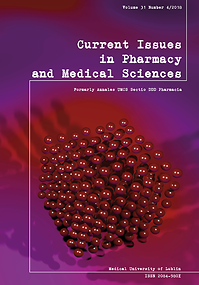Frequency of JC Virus Appearance in the Urine of Post-Transplantation Patients
DOI:
https://doi.org/10.1515/cipms-2018-0011Słowa kluczowe:
polyomavirus, JC virus, transplantation, bone marrow, kidneyAbstrakt
Polyomaviruses are common viruses that induce various infections in many mammalian species, including humans. The best-known viruses of this kind are BKV and JCV. The aim of the study was to analyze the incidence of infection caused by JCV in a group of patients after kidney or bone marrow transplant, and to analyze JCV genetic diversity in post-transplantation recipients. The study group included 81 patients after kidney transplantation treated in the Independent Public Teaching Hospital No 4 in Lublin and a group of 24 patients after marrow transplantation from the Children's Clinical Hospital of Lublin. The research material included 105 DNA probes from urine samples that were tested via the PCR method for the presence of JCV genetic material. Amplification products were separated in agarose gel, positive PCR products were subjected to purification and the pure product was sent to sequencing. Pearson's chi-square test was used to investigate the relationship between the prevalence of JCV viruria and study group and gender. Statistical significance was defined as p < 0.05. A JCV positive result was discovered in 27.6% of all samples. In the group of adults, 34.6% were positive, while in children, this was 3.4%. Among all patients, only 8 women were infected with the JC virus, while 21 men were. We saw that the incidence of infection caused by the JC virus increases with age. Moreover, JCV DNA is more frequently isolated from men than from women. JCV infections are also a more common cause of infections in patients after renal transplantation than in bone marrow transplant patients
Bibliografia
1. Barth H, Solis M, Lepiller Q, Sueur C, Soulier E, Caillard S, et al. 45 years after the discovery of human polyomaviruses BK and JC: Time to speed up the understanding of associated diseases and treatment approaches. Crit Rev Microbiol. 2017;43(2):178-95.
2. Delbue S, Ferraresso M, Ghio L, Carloni C, Carluccio S, Belingheri M, et al. A review on JC virus infection in kidney transplant recipients. Clin Dev Immunol. 2013; ID92639.
3. Antonsson A, Green AC, Mallitt KA, O’Rourke PK, Pawlita M, Waterboer T, et al. Prevalence and stability of antibodies to the BK and JC polyomaviruses: a long-term longitudinal study of Australians. J Gen Virol. 2010;91:1849-53.
4. Jiang M. Abend JR, Johnson SF, Imperiale MJ. The role of polyomaviruses in human disease. Virology. 2009;384:266–73.
5. Krumbholz A, Bininda-Emondsb O, Wutzlera P, Zella R. Phylogenetics, evolution, and medical importance of polyomaviruses. Infect Genet Evol. 2009;9:784–99.
6. Beltrami S, Gordon J. Immune surveillance and response to JC virus infection and PML. J Neurovirol. 2014;20(2):137-49.
7. Boothpur R, Brennan DC. Human polyoma viruses and disease with emphasis on clinical BK and JC. J Clin Virol 2010;47:306-12.
8. Hirsch HH, Knowles W, Dickenmann M, Passweg J, Klimkait T, Mihatsch MJ, et al. Prospective study of polyomavirus type BK replication and nephropathy in renal-transplant recipients. N Engl J Med. 2002;347:488-96.
9. Kmieciak D, Dębicki S, Trzeciak WH. Occurrence rate and genotype distribution of the JC virus (JCV) in a sample from the Polish population. J Medical Virol. 2008;80:1079-83.
10. Dalianis T., Hirsch H.: Human polyomaviruses in disease and cancer. Virology. 2013;437(2):63-72.
11. Ferenczy MW, Marshall LJ, Nelson CD, Atwood WJ, Nath A, Khalili K, et al. Molecular Biology, Epidemiology, and Pathogenesis of Progressive Multifocal Leukoencephalopathy, the JC Virus-Induced Demyelinating Disease of the Human Brain. Clin Microbiol Rev. 2012;25(3):471–506.
12. Boukoum H, Nahdi I, Sahtout W, Skiri H, Aloui S, Achour A, et al. BK and JC polyomavirus infections in Tunisian rental transplant recipient. J Medical Virol. 2015;87:1788-95.
13. Boukoum H, Nahdi I, Sahtout W, Skiri H, Segondy M, Aouni M. BK and JC virus infections in healthy patients compared to kidney transplant recipients in Tunisia. Microb Pathog. 2016;97:204-8.
14. Saundh BK, Baker R, Harris M, Hale A. A prospective study of renal transplant recipients reveals an abscenceof primary JC polyomavirus infections. J Clin Virol. 2016;77:101-5.
15. Agostini HT, Yanagihara R, Davis V, Ryschkewitsch CF, Stoner GL. Asian genotypes of JC virus in Native Americans and in a Pacific Island population: markers of viral evolution and human migration. Proc Natl Acad Sci. 1997;94:14542-46.
16. Dubois V, Moret H, Lafon ME, Brodard V, Icart J, Ruffault A, et al. JC virus genotypes in France: molecular epidemiology and potential significance for progressive multifocal leukoencephalopathy. J Infect Dis. 2001;183(2):213-17.
17. Agostini HT, Deckhut A, Jobes DV, Girones R, Schlunck G, Prost MG, et al. Genotypes of JC virus in East, Central and Southwest Europe. J Gen Virol. 2001;82:1221-31.
Pobrania
Opublikowane
Numer
Dział
Licencja
Prawa autorskie (c) 2018 Autorzy

Praca jest udostępniana na licencji Creative Commons Attribution-NonCommercial-NoDerivatives 3.0 Unported License.


